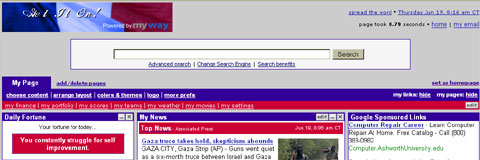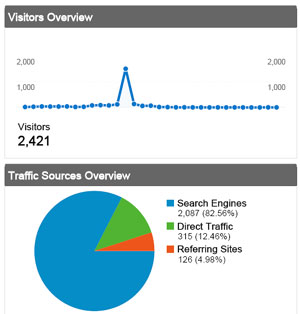Redeclaring My Independence
As I wrote my entry on Independence Day, I began thinking a lot about my own independence, namely in owning my own business.
When I set out and started Dunkirk Systems, LLC over 3 and a half years ago, it was with attitude and bravado that I could actually do what I wanted the way I wanted. This type of thinking wasn’t always with me, and surely wasn’t the case about 4 years earlier when faced with a decision to go out on my own or get a full-time job with a company, as I chose the latter. At the time it was the right choice for me. It was during that period where the desire to work a certain way came to the surface, and when I moved to Chicago, I felt there was no time like the presence to start my business.
Like many entrepreneurs, I saw events and activities in my business playing out a certain way. Call it optimism, or call it dreaming, but you play things out in your mind’s eye as they unfold, hoping they play out in real-life the same way. But like life itself, you cannot predict what will truly happen. You may lose the client you thought you had locked up, only to gain the client you never saw coming. Where these are the large events, many small events occur on an almost daily basis. This is why I say everyday I learn something new about owning my own business.
Recently I have been thinking more and more about how my business has progressed, and what course I want to take next. As this holiday weekend unfolds I will be putting a lot of thought into my business and how I see it going forward. In this reflection, I will look at what has worked, what has not, what surprises I encountered and how I reacted to them. I will also take a hard look at where I want to go, and what it will take me to get there. Equally, I will take a look at my life outside of work, off the grid, and what goals and plans I have for it. I want to make sure by having my own business I don’t negatively impede my personal desires and activities.
On this journey I have tried to have no regrets, and so far so good. In redeclaring my independence I will reaffirm my choice and make any adjustments necessary for the next stage in this journey.
Business • (7) Comments • PermalinkHappy Independence Day
 As I was off the grid yesterday, July 4, I would like to wish everybody a belated yet no less Happy Independence Day!
As I was off the grid yesterday, July 4, I would like to wish everybody a belated yet no less Happy Independence Day!
After a relatively quiet day, I got home and caught up on the local news. During the newscast, the anchor said they were conducting a survey asking viewers if they felt they were patriotic. Where this query did not diminish my reflections on the freedoms we have in the US, it was sad this question keeps coming up in the media.
One thought on patriotism that came to me yesterday was what I did on my 18th birthday, many years ago. After having a great breakfast at home from my Mom, I hopped in the car and made 2 stops. First I went to my hometown’s town hall and registered to vote. From there, I went to the post office and registered for the draft. Where both of these actions are vital to being an American, I felt doing these in this order important, especially if I had any feelings or reservations over the draft. Through my active participation in the democracy that is the US, I could help make a difference.
Happy 232nd birthday to the United States of America, and here’s to many, many more.
Announcements • Diversions • (1) Comments • PermalinkGoodbye MyWay.com Hello iGoogle
After much deliberation, I have replaced MyWay.com with iGoogle. As I lamented previously, MyWay, a news and information portal, replaced their highly-functional stock portfolio system with a widget from Scottrade. As a result, the ability to manage multiple lists of stock and funds went away for a Flash object that forces you to scroll rather to seeing everything at once. This move, plus the fact they did not inform users and a general lack of innovation over the years forced me to look elsewhere. As comments to my original post show, I was not alone.
Here’s a screenshot of the top of my old MyWay page:

And here’s a screen shot of the top of my new iGoogle page:

I was always aware of iGoogle as I have a Google account. However my initial reaction to it when it launched a while back was to not drink anymore Google Kool-Aid than I had to! With MyWay’s move, I decided to give it another, objective look, and I liked what I saw. I was able to configure iGoogle with news sources and categories of information as I had with MyWay, and then some. The portfolio feature I lost with MyWay I was able to restore with iGoogle.
iGoogle allows a user to add a “gadget” which can be news headlines, sports scores, RSS feeds, games, et. al. There were gadgets for headlines from newspapers like the Chicago Tribune as well as international media sources. You can even develop your own gadgets for potential inclusion. You can also customize the presentation of information with themes. I haven’t experimented with themes much as I was focused on content, and there’s still a lot of widgets for me to look into.
If you use MyWay, I recommend taking a look at iGoogle. I still have my MyWay account, and will probably hold on to it for a while as a backup.
Technology • (10) Comments • PermalinkMy Take-Aways From The Book The Venture Cafe
As the saying goes, it takes money to make money. This is something I learned first-hand when I started my own business, Dunkirk Systems, LLC, several years ago. In my case, I bootstrapped my business – used savings as well as revenues to grow and expand my business. It has worked for me as it fits the size and scope of my business. But bootstrapping isn’t for everyone, and not just people who don’t have money to invest in a business. Some business ideas require a large amount of cash for research and manufacturing, and this is where venture capital can come into play.
Venture capital, or VC, is a large part of the story of the book The Venture Cafe by Teresa Esser. It is a non-fiction piece about entrepreneurs and those with business or product ideas and how they go about taking those ideas forward. The notion of a cafe stems from the author’s experience with a pub on the campus of MIT in Cambridge, MA where people with gather to talk thru various business and technology ideas. The book follows the path from idea to established companies, and throughout are interviews with people at various stages themselves, including the author’s own personal stories.
My greatest takeaway from the book is you cannot do it alone. Whether you need financial or human capital or merely cheerleaders on the sidelines, to grow and be a true business you need resources that will surely go beyond yourself. This can be hard for some who are, using a term I commonly use, control-freak entrepreneurs. It is not letting go, it is empowering others. And things may not go exactly as you have planned, especially when using other people’s money.
An equally important takeaway is accountability, to everybody including the investors to employees to you. Investors want to know how and why their money is being spent, and if they will make a profit or not. This may mean making hard, unpopular decisions, but to pursue the goal and move forward, they have to be made.
A final takeaway is that you may fail. Where another saying says failure is not an option, it can happen, and if it does, you need to react to it. One example in the book is about an executive who loses everything, yet in his next opportunity he excels to an extreme. Recovering from this failure, or bouncing back, shows the true mettle of a person.
I enjoyed The Venture Cafe, especially for someone who was living in the Boston area around the time it was written. Many of the people and companies were ones I was familiar with. Though it was published in 2002 and talks much of the dot-com bust of that period, many of the stories and lessons learned from it apply today. And as much as the book is about VC, it does not profess it is the only way to go, and provides takes of those who chose VC and those who did not for their business. I recommend this book for anyone who may want to reminisce about the past, and learn from it to empower the future.
This is from The Hot Iron, a journal on business and technology by Mike Maddaloni.
Did you enjoy this? Subscribe to The Hot Iron by RSS/XML feed or Read by Email.
Book Take-Aways • Business • Technology • (0) Comments • Permalink
Start Somewhere With Web Analytics
 Do you know how many hits your Web site gets? Is this question something you even think about?
Do you know how many hits your Web site gets? Is this question something you even think about?
There are a lot of moving parts to a Web site, from technology to content to usability to whether or not the Web site is even up and running. Even if you are working with a trusted partner such as Dunkirk Systems, LLC, for the business owner or stakeholder it can be overwhelming the amount you need to be cognizant of with regards to your Web site.
One aspect of a Web site commonly placed lower on the priority list is Web analytics, or the review and analysis of traffic to your Web site. Analytics involves the number of hits on Web pages, the cluster of those hits called a visit, whether the visit is new or returning, when and how long the visitor was at your Web site, how they navigated the Web site, how did they come about your Web site and with what computer and browser.
If the preceding paragraph did not overwhelm you, congratulations! The above is a lot to digest, but you realized its importance. If you previously had not thought much about analytics, you may be wondering where to start.
My recommendation on Web analytics is to start on a basic level. First, reacquaint yourself with your system for viewing and analyzing this information. It may be available from a number of sources. Most all Web hosting companies offer some form of analytics, from raw Web log files (where hits to your Web site are recorded) to a Web-based interface to review the information captured in these files. Even if you Web host offers this, you may have available to you services for analysis, such as Google Analytics, which are third-party services that collect Web hit information based on a small piece of code added to each Web page that is not viewable to the Web user.
Now that you have your Web analytics software in front of you, take a look at the basic or “dashboard” information. This is typically what you see when you first log into the analytics Web site. Now peruse through this information. Take a look at the various reports, whether in tables or graphs, and familiarize yourself with what is presented. At first it may not mean much. However over time and repeated review of this information, you will get a feel for how people use your Web site.
The accompanying graphic with this post is an example of part of a dashboard report for a real Web site I manage and whose name I am purposely not stating at this time. Note there is a huge spike in traffic in the reporting period. I show this example as you may have similar occurrences with your own Web site, and with a better understanding of your analytics, you’ll be able to better understand why this happened, as I did with this Web site.
Continued review of your Web analytics will help you recognize the utilization of your Web site, understand the effectiveness of content and information presented on it and guide you in decision making in how you update and change your Web site. This task also has some complexity to it, but it is helped by understanding the numbers. And to do so, you need to start somewhere.
Business • Technology • (0) Comments • Permalink
Page 147 of 214 pages ‹ First < 145 146 147 148 149 > Last ›



